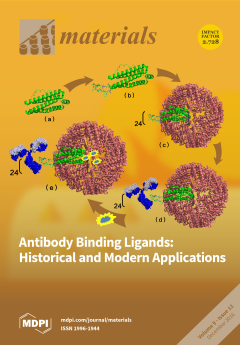Open AccessArticle
Synthesis and Structural Characterization of Silver Nanoparticles Stabilized with 3-Mercapto-1-Propansulfonate and 1-Thioglucose Mixed Thiols for Antibacterial Applications
by
Francesco Porcaro, Laura Carlini, Andrea Ugolini, Daniela Visaggio, Paolo Visca, Ilaria Fratoddi, Iole Venditti, Carlo Meneghini, Laura Simonelli, Carlo Marini, Wojciech Olszewski, Nitya Ramanan, Igor Luisetto and Chiara Battocchio
Cited by 59 | Viewed by 6483
Abstract
The synthesis, characterization and assessment of the antibacterial properties of hydrophilic silver nanoparticles (AgNPs) were investigated with the aim to probe their suitability for innovative applications in the field of nanobiotechnology. First, silver nanoparticles were synthetized and functionalized with two capping agents, namely
[...] Read more.
The synthesis, characterization and assessment of the antibacterial properties of hydrophilic silver nanoparticles (AgNPs) were investigated with the aim to probe their suitability for innovative applications in the field of nanobiotechnology. First, silver nanoparticles were synthetized and functionalized with two capping agents, namely 3-mercapto-1-propansulfonate (3MPS) and 1-β-thio-
d-glucose (TG). The investigation of the structural and electronic properties of the nano-systems was carried out by means of X-ray Photoelectron Spectroscopy (XPS) and X-ray Absorption Spectroscopy (XAS). XPS data provided information about the system stability and the interactions between the metallic surface and the organic ligands. In addition, XPS data allowed us to achieve a deep understanding of the influence of the thiols stoichiometric ratio on the electronic properties and stability of AgNPs. In order to shed light on the structural and electronic local properties at Ag atoms sites, XAS at Ag K-Edge was successfully applied; furthermore, the combination of Dynamic Light Scattering (DLS) and XAS results allowed determining AgNPs sizes, ranging between 3 and 13 nm. Finally, preliminary studies on the antibacterial properties of AgNPs showed promising results on four of six multidrug-resistant bacteria belonging to the ESKAPE group (
Enterococcus faecium,
Staphylococcus aureus,
Klebsiella pneumoniae,
Acinetobacter baumannii,
Pseudomonas aeruginosa, and
Enterobacter sp.).
Full article
►▼
Show Figures






